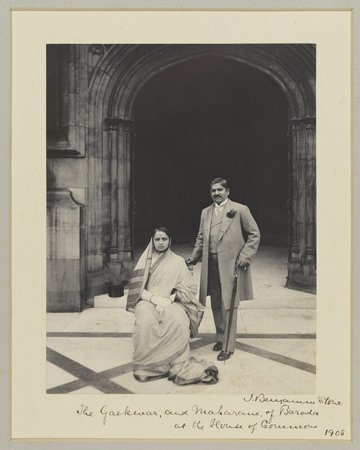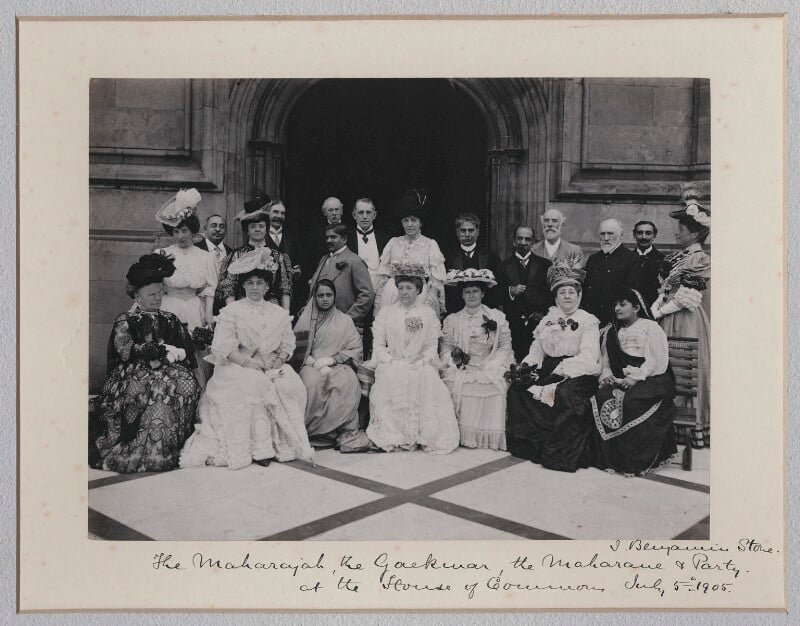
Sayaji Rao
‐
Maharaja of Baroda
Other names
Sayaji Rao, Maharaja of Baroda III
Sayaji Rao Gaekwad
Place of birth
Date of arrival to Britain
Place of death
Bombay, India
Date of time spent in Britain
1887, early 1930s
About
Sayaji Rao was the son of Kashi Rao, a village headman who belonged to the Maratha family that had created the state of Baroda in Gujarat during the eighteenth century. He took the name Sayaji Rao III when he was installed on the gadi or throne of Baroda in May 1875. Sayaji Rao was invested with governing powers in December 1881, shortly before his nineteenth birthday.
In order to relieve health problems reputedly brought on by overwork and variously described as neurasthenia or nervous prostration, sleeplessness and gout, he made his first trip to England in 1887. Various Indian figures worked for the Maharaja. Dadabhai Naoroji was his minister in 1874, and Aravinda Ghose worked in the Baroda service after his return from England in 1893. He sponsored B. R. Ambedkar's education in Bombay and the US.
Sayaji Rao's second wife, Chimnabai II, was the first President of the All India Women's Conference in 1927. She co-wrote The Position of Women in Indian Life (1911) with S. M. Mitra. Sayaji Rao had three children from his first marriage and three children from his second. His daughter from his second marriage married the Prince of Cooch Behar and was well known in 'society' circles in London in the 1920s and 1930s. In spite of his open support for the Indian National Congress, Sayaji Rao was awarded a GCIE in 1919.
After 1919 Sayaji Rao travelled and lived in Europe and Britain for several months each year. After spending most of the 1930s travelling to seek relief for health problems at various European spas, Sayaji Rao III returned to India in November 1938. He died in Bombay on 6 February 1939.
B. R. Ambedkar, Fanindranath Bose (sculptor), Sunity Devee (Maharani of Cooch Behar, mother-in-law of his daughter), Romesh Chunder Dutt, Aravinda Ackroyd Ghose, S. M. Mitra (wrote with his wife), Dadabhai Naoroji.
Notes on the Famine Tour by His Highness the Maharaja Gaekwar (London: n.p., 1901)
Speeches and Addresses (Cambridge: Privately printed at the University Press, 1927)
(with Alban Gregory Widgery, Cyril Ernest Newham and Kenneth Saunders) Speeches & Addresses of His Highness Sayaji Rao III, Maharaja of Baroda, 4 vols (London: Macmillan & Co., 1927–38)
(with Anthony Xavier Soares) Speeches and Addresses...Selected and Edited by Anthony X. Soares (London: Oxford University Press, 1933)
Bhagavan, M. B., 'Higher Education and the "Modern": Negotiating Colonialism and Nationalism in Princely Mysore and Baroda', unpublished PhD thesis (University of Texas, 1999)
Bottomore, S., '"Have You Seen the Gaekwar Bob?": Filming the 1911 Delhi Durbar', Historical Journal of Film, Radio and Television 17 (1997), pp. 309–45
Copland, I., 'The Baroda Crisis of 1873–77', Modern Asian Studies 2 (1968), pp. 97–123
Copland, I., 'Sayaji Rao Gaekwar and "Sedition"', in Peter Robb and David Taylor (eds) Rule, Protest, Identity: Aspects of Modern South Asia (London: Curzon Press, 1978), pp. 28–48
Gaekwad, Fatesinhrao, Maharaja of Baroda, Sayajirao of Baroda: The Prince and the Man (London: Sangam, 1989)
Gense, James H., Banaji, D. R. and Maharaja of Baroda Sayaji Rao Gaekwar III, The Gaikwads of Baroda. English Documents. Edited by J. H. Gense...D. R. Banaji. Vol. 2–10 (Bombay: D. B. Taraporevala Sons & Co., 1937)
Hardiman, D., 'Baroda: The Structure of a Progressive State', in Robin Jeffrey (ed.) People, Princes and Paramount Power: Society and Politics in the Indian Princely States (Oxford: Oxford University Press, 1978), pp. 107–35
Nuckolls, C. W., 'The Durbar Incident', Modern Asian Studies 24 (1990), pp. 529–59
Ramusack, Barbara N., 'Gaikwar [Gaekwar], Sayaji Rao [Sayaji Rao III], Maharaja of Baroda (1863–1939)', Oxford Dictionary of National Biography (Oxford University Press, 2004) [http://www.oxforddnb.com/view/article/30613]
Rice, Percival Stanley Pitcairn, and Maharaja of Baroda Sayaji Rao Gaekwar III, Life of Sayaji Rao III Maharaja of Baroda, 2 vols (London: Oxford University Press, 1931)
Sergeant, Philip Walsingham and Maharaja of Baroda Sayaji Rao Gaekwar III, The Ruler of Baroda: An Account of the Life and Work of the Maharaja Gaekwar (Sayajirao iii) (London: John Murray, 1928)
The Times (7 February 1939)
Weeden, Edward St Clair and Maharaja of Baroda Sayaji Rao Gaekwar III, A Year with the Gaekwar of Baroda...With 25 Illustrations from Photographs, Etc. (London: Hutchinson & Co., 1912)
Widgery, Alban Gregory and Maharaja of Baroda Sayaji Rao Gaekwar III, Goods and Bads. Outlines of a Philosophy of Life: Being the Substance of a Series of Talks and Discussions with H. H. The Maharajah Gaekwar of Baroda (Baroda: A. G. Widgery, 1920)
Wodehouse MSS, Bodleian Library, Oxford
Hardinge MSS, Cambridge University Library, Cambridge
MSS, Gujarat State Archives, Southern Circle, Vadodara, Gujarat, India

The Maharaja and Maharani of Baroda and party on the Terrace of the House of Commons by Benjamin Stone, platinum print, 5 July 1905, NPG x135610
© National Portrait Gallery, London, Creative Commons, http://creativecommons.org/licenses/by-nc-nd/3.0/
Image credit
Chimnabai II, Maharani of Baroda; Sir Sayaji Rao III, Maharaja of Baroda by Benjamin Stone, platinum print, 5 July 1905, NPG x36466
© National Portrait Gallery, London, Creative Commons, https://creativecommons.org/licenses/by-nc-nd/3.0/
